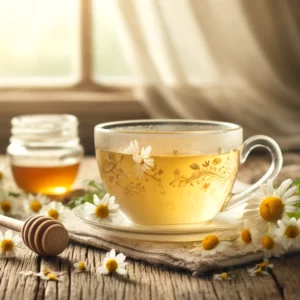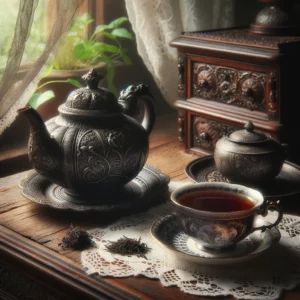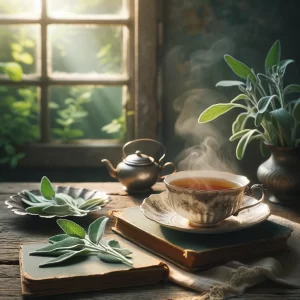Darjeeling Green Tea is a treasure from the foothills of the Himalayas, cherished by tea lovers around the world for its delicate flavor and aromatic freshness. Unlike other green teas, it boasts a unique character shaped by the misty climate of Darjeeling, India. This blog post takes you on an in-depth journey through the world of Darjeeling Green Tea, from its roots to your teacup. Whether you’re a curious newcomer or a seasoned tea enthusiast, join us as we explore what makes this tea so special.
Table of Contents
- The Story of Darjeeling Green Tea
- What Makes Darjeeling Green Tea Unique?
- Brewing the Perfect Cup of Darjeeling Green Tea
- Enjoying Darjeeling Green Tea in Various Ways
- Pairing Darjeeling Green Tea with Foods
- Finding and Storing Darjeeling Green Tea
- Cultivation and Processing of Darjeeling Green Tea
- Conclusion
The Story of Darjeeling Green Tea
Darjeeling, often referred to as the “Champagne of Teas,” is a region in India known for producing some of the world’s finest teas. Darjeeling Green Tea, with its unique flavor profile, is one of the jewels in its crown. The tea gardens in Darjeeling are situated at high elevations, where the cool, misty climate and rich soil create perfect conditions for growing tea.
The history of Darjeeling tea dates back to the 19th century when the British colonial administration began tea cultivation in the region. Initially, Darjeeling was known for its black teas, but over time, green tea production began to flourish. Unlike black tea, Darjeeling Green Tea is not oxidized, which helps retain its green color and fresh, vegetal flavors.
What Makes Darjeeling Green Tea Unique?
What sets Darjeeling Green Tea apart is its complex flavor profile. It has a delicate taste with floral, fruity, and sometimes nutty undertones. The exact flavor can vary depending on the harvest period, with the first flush (spring harvest) being the most prized for its light, aromatic qualities.
Key characteristics include:
- Appearance: Bright green, tightly rolled leaves.
- Aroma: Fresh, with a hint of muscatel and floral notes.
- Flavor: Light and refreshing, with a varying balance of sweetness, astringency, and floral notes.
The uniqueness of Darjeeling Green Tea also lies in its production process, which is carefully monitored to ensure the leaves retain their flavor and aroma.
Brewing the Perfect Cup of Darjeeling Green Tea
To fully enjoy the delicate flavors of Darjeeling Green Tea, proper brewing is essential. Here’s how to brew the perfect cup:
- Water Temperature: Use water heated to about 170-185°F (77-85°C). Boiling water can scorch the leaves, affecting the tea’s flavor.
- Tea Quantity: Use about 1 teaspoon of tea leaves for every 8 ounces of water.
- Steeping Time: Steep the leaves for 2-3 minutes. Over-steeping can make the tea bitter.
Tips:
- Always use fresh, filtered water for the best taste.
- Pre-warm your teapot or cup by rinsing it with hot water before brewing.
Enjoying Darjeeling Green Tea in Various Ways
Darjeeling Green Tea is versatile and can be enjoyed in several ways. Whether you prefer it plain to savor its natural flavors, or with a dash of lemon or honey to add a different taste profile, there’s no wrong way to enjoy it. For a refreshing twist, try making iced Darjeeling Green Tea on a hot day.
Pairing Darjeeling Green Tea with Foods
Pairing food with Darjeeling Green Tea can enhance your tea experience. Light snacks and meals complement its delicate flavors best. Here are some pairing suggestions:
- Scones and pastries: Their mild sweetness pairs well with the tea’s floral notes.
- Fruit salads: The freshness of the fruit complements the tea’s light body.
- White and light cheeses: Their creaminess balances the tea’s astringency.
Finding and Storing Darjeeling Green Tea
When looking for high-quality Darjeeling Green Tea, look for teas that specify their flush (harvest period) and are from reputable gardens. Specialty tea shops and online retailers often provide the best selections.
Storage tips:
- Keep the tea in a cool, dark place.
- Store it in an airtight container to protect it from air, moisture, and odors.
Cultivation and Processing of Darjeeling Green Tea
The cultivation and processing of Darjeeling Green Tea are intricate processes that significantly impact its flavor. The tea bushes are grown on steep slopes, and the leaves are hand-picked with great care. After plucking, the leaves are withered, rolled, and then dried without undergoing oxidation, which preserves their green color and fresh flavor.
Conclusion
Darjeeling Green Tea is a delightful beverage that offers a unique taste experience. From its rich history and distinctive flavor profile to the art of brewing and enjoying it, Darjeeling Green Tea is more than just a drink—it’s a journey. We encourage you to explore and savor this exquisite tea in all its varieties and forms. Whether you’re enjoying a quiet moment alone or sharing it with friends, Darjeeling Green Tea is sure to refresh and delight.
Try Darjeeling Green Tea
“As an Amazon Associate I earn from qualifying purchases.”
[azonpress template=”grid” asin=”B0DPX8Y3ZZ,B09CNMX1GG,B09CNLK4GD,B00VFYPG1S”]



